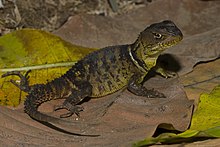| This article needs additional citations for verification. Please help improve this article by adding citations to reliable sources. Unsourced material may be challenged and removed. Find sources: "Dunn's spinytail lizard" – news · newspapers · books · scholar · JSTOR (October 2023) (Learn how and when to remove this message) |
| Dunn's spinytail lizard | |
|---|---|

| |
| Enyalioides groi in Anton Valley, Panama | |
| Conservation status | |
 Endangered (IUCN 3.1) | |
| Scientific classification | |
| Domain: | Eukaryota |
| Kingdom: | Animalia |
| Phylum: | Chordata |
| Class: | Reptilia |
| Order: | Squamata |
| Suborder: | Iguania |
| Family: | Hoplocercidae |
| Genus: | Enyalioides |
| Species: | E. groi |
| Binomial name | |
| Enyalioides groi (Dunn, 1933) | |
| Synonyms | |
| |
Enyalioides groi, known commonly as Gro's manticore, Dunn's spinytail iguana, or Dunn's spinytail lizard, is a species of lizard in the family Hoplocercidae. The species is native to northwestern South America and Panama.
Etymology
The specific name, groi, commemorates "Lord Gro", a character in the novel The Worm Ouroboros by E. R. Eddison.
Geographic range
E. groi is found in central Panama and in northwestern Colombia.
Habitat
The preferred natural habitat of E. groi is forest, at altitudes of 600–900 m (2,000–3,000 ft).
Description
The tail of E. groi is covered with small spines. Males are reddish-brown with dark brown transverse bands across the back, reaching to the middle of the sides and then breaking up into small, irregular dark spots. Small white spots occur between the dark bands above the first longitudinal row of tubercles. The neck is red, with an incomplete white collar three to five scales wide, extending somewhat obliquely from just ahead of the forearm upward to the scapular region; the collar is edged on both sides by dark brown. The head is reddish and the chin and infralabial region scarlet red. The gular area is dark grayish-brown, the chest is pale chrome orange, and the belly is dirty white. Adult females are essentially the same color, lacking the scarlet red in the infralabial region, and the belly is yellow.
Behavior
E. groi lives in burrows it excavates itself, especially under fallen logs.
Reproduction
E. groi is oviparous.
See also
References
- ^ Ibáñez R, Jaramillo C, Castañeda MR, Renjifo J, Bolívar W, Velasco J (2016). "Morunasaurus groi ". The IUCN Red List of Threatened Species 2016: https://dx.doi.org/10.2305/IUCN.UK.2016-1.RLTS.T203070A2759787.en. Accessedon 12 October 2023.
- ^ Species Enyalioides groi at The Reptile Database www.reptile-database.org.
- Beolens, Bo; Watkins, Michael; Grayson, Michael (2011). The Eponym Dictionary of Reptiles. Baltimore: Johns Hopkins University Press. xiii + 296 pp. ISBN 978-1-4214-0135-5. (Morunasaurus groi, p. 109).
Further reading
- Corredor, Vladimir; Renjifo, Juan Manuel; Ayala, Stephen C. (1985). "Discovery of Morunasaurus groi Dunn (Sauria, Iguanidae) in Northwestern Colombia". Journal of Herpetology 19 (1): 162–164.
- Dunn ER (1933). "Amphibians and Reptiles from El Valle de Anton, Panama". Occasional Papers of the Boston Society of Natural History 8: 65–79. (Morunasaurus, new genus, pp. 75–76; Morunasaurus groi, new species, pp. 76–77).
- Köhler G (2008). Reptiles of Central America, 2nd Edition. Offenbach, Germany: Herpeton Verlag. 400 pp. ISBN 978-3936180282. (Morunasaurus groi, p. 82).
- Torres-Carvajal, Omar; Werneck, Fernanda P.; Fernandes, Igor Yuri; de Queiroz, Kevin (2023). "Spiny tails and clades: A fully sampled phylogeny of hoplocercine lizards (Iguanidae/ Hoplocercinae) and its taxonomic and nomenclatural implications". Bulletin of Phylogenetic Nomenclature 1 (1): 8–28. (Enyalioides groi, new combination).
| Taxon identifiers | |
|---|---|
| Morunasaurus groi | |
This lizard article is a stub. You can help Misplaced Pages by expanding it. |